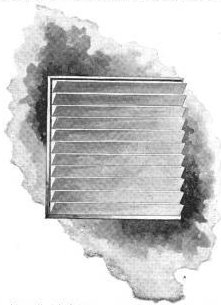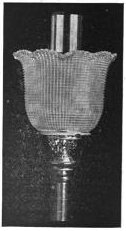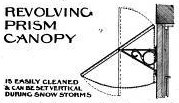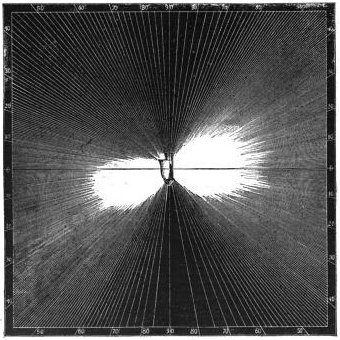|
Up: Prism Glass |
Light Diffusing Media Home > Prism Glass > Light Diffusing Media |
Prism Paper 8 of 11 |
|
Up: Prism Glass |
Light Diffusing Media Home > Prism Glass > Light Diffusing Media |
Prism Paper 8 of 11 |
| December 1, 1900 | THE SCHOOL JOURNAL. | 567 |
|
| ||
Light Diffusing Media.No subject is exciting keener interest
among architects just at present than the use of the various forms of
prismatic, ribbed, and maze glass in securing a more effective use of
natural and artificial light. The importance of this matter in schools
can hardly be overestimated. One of the first conditions for effective
and healthful work is plenty of light. In most schools the students
near the windows suffer from too strong light while those at a distance
sit in comparative darkness. Very much of the nearsightedness as well
as the extreme nervousness of our school children grows out of habits
of reading or study in badly lighted rooms at home or at school. ![An exterior installation [of prism glass] An exterior installation [of prism glass]](an_exterior_installation.jpg) An Exterior Installation. The Atkinson-Norton Experiments.An account of important experiments in
regard to the diffusion of light performed by Mr. C. L. Norton at the
Massachusetts Institute for Technology was printed in THE
SCHOOL JOURNAL
for Nov. 3.
Commercial Applications of Prismatic Glass.Of the four forms of glass tested in
the Atkinson-Norton experiments the prism glass seems to be the most
satisfactory. Whether the so-called "factory-ribbed" glass which showed
up so well in the tests will immediately be commercially available
remains to be seen.
Luxfer Prisms.The products of the
American Luxfer Prism Company, of Chicago
and New York, have for several years been available for purpose of school
lighting. They have already been installed in a great many educational
institutions. An installation which Mr. A. P. O'Brien, manager of the
New York office, happened to be figuring on when a SCHOOL
JOURNAL representative visited him was in the Albany,
N.Y., high school. Other schools in the neighborhood of New York which
already have the Luxfer prisms are as follows:
St. Mary's school, 8 East Forty-Sixth
street; Trinity church school, 70 Church street; public school No.
42, Allen street, near Hester street; school, 168 West 79th street;
Morristown high school, Morristown, N.J. The Ethical Culture school,
129 West 34th street.
What Luxfer Prisms Are.Luxfer prisms are section of crystal glass of
a standard dimension of four inches square, having a smooth outer surface
and an inner surface divided into a series of small accurately formed
prisms. This size has been found by experience to be most convenient,
both for the manufacturers and for the building architects. It is also
artistically best suited for the type of window that prevails in the
modern buildings of to-day.
 There are a great many varieties of prism
used, so that the Luxfer company finds it advisable for one of their
own engineers to study the problem of each installation where that is
possible. Each case requires some special treatment, being dependent
not only upon the size and shape of rooms and windows, but upon the
surroundings of the building, and the direction from which light comes to
the window. One of the strongest points made by this company is that
they study each problem of lighting in a scientific fashion much as an
expert oculist studies the problems of getting light to the retina of
the eye in the best possible fashion. The commonest Luxfer arrangement
provides for a lower sash, glazed with plane glass and an upper sash of
prism glass, the size and quality of this varying greatly according to
the nature of the interior to be lighted.
Most of the big department stores are now
saving on their electric light bills by introducing this form of glass.
The New York, Philadelphia, Boston, and Chicago stores are already well
equipped with it.
One other point that is made by the Luxfer
people is worth noting. Their glass does not merely perform the function
of a light transmitter; it also becomes part of the architectural
decoration of the building. It is a known fact among architects that
ordinary window glass does not enter properly into artistic harmony with
the other elements, but is rather a necessary evil. Hence the extensive
use of stained glass in buildings where an aesthetic effect is sought.
The Luxfer prisms when properly applied, even to the most expensive
and ornate buildings, are found to be a highly ornamental feature in
the entire façade. When looked at from the outside, they do not
have the appearance of glass at all. This is, of course, a consideration
in the erection of modern school-houses in which use and beauty go side
by side.
The Diffusion of Artificial Light.Hardly less important to the school
than the correct distribution of daylight is the question of the
diffusion of artificial light. Wherever there are night classes, in
libraries and reading rooms, in physical laboratories and studios,
the problem of getting a light that is physiologically harmless and
usable educationally must be faced.
|
It is well known that students in evening classes are especially
liable to afflictions of the eyes. Library work, too, even under the best
conditions is very trying in the evening. Anyone who has sat face to
face with an incandescent light in a college library for four hours is
likely to know how essential it is that the new discoveries in the way
of diffusion of light shall be applied to interior illumination.
As a general statement it may be said that
progress in the last few years has been in the direction of producing
light sources of great intensity. The arc and incandescent electric
lights were a step in this direction. When [Carl]
Auer von Welsbach
made his remarkable discovery of a means for utilizing the hitherto
unconsumed elements in gaslight, thereby increasing its efficiency seven
or eight times, he added another powerful illuminator to the list.
Very lately acetylene gas has been found to be capable of producing
an intense white light that almost vies with daylight in brilliancy.
All these new forms of illumination are powerful and, unmodified, full
of physiological danger.
What Good Illumination Requires.Primarily there should be a sufficient
amount of light thrown upon the objects to render them easily visible;
and in looking at the objects the eye should not be dazzled by intense
rays direct from the source itself.
The Holophanes.The first attempt on a large scale to make a
commercial application of the principles of diffused light to artificial
illumination is now being made by the Holophane Company, of New York.
 This firm has adopted the form of prismatic glass that was worked out by
Blondel and
Psarondaki, two Parisian scientists, in strict accordance with optical
laws. What they claim for the Holophane glass is that it embodies the
following requisites in lighting:
This firm has adopted the form of prismatic glass that was worked out by
Blondel and
Psarondaki, two Parisian scientists, in strict accordance with optical
laws. What they claim for the Holophane glass is that it embodies the
following requisites in lighting:
The Holophane globes are made of transparent
glass, so that none of the light rays are intercepted. The inner surface
of the glass is given over to carefully calculated flutings or prisms
used solely for diffusing or softening the light without loss of power.
On the outside face are prisms calculated for reflecting these diffused
rays into directions where needed.
In practice, Holophane glass, when placed
over a light, will render a dazzling light soft and healthful, while
increasing its effective illuminating power.
The "Luminous Prisms."Another firm which has begun
to do some work in the way of school installations is the New
York Prism Company, of 473 West Broadway, New York. Their business
thus far has been principally with private schools, tho they have
had some orders from the boards of education of Philadelphia,
Cleveland, and Chicago. In New York city they have supplied
prismatic glass to the following institutions: The Normal college;
the Brearley school; the Berkley school; the Cornell medical college;
the Chapin Collegiate school.

This prism company has recently printed
"Natural Light for School-Rooms," an essay addressed to the National
Educational Association, at Charleston. In this essay the facts about
prismatic lighting are very succinctly and forcibly stated. It should
be in the hands of every student of school hygiene in the country.
This firms employs a lucical engineer who
makes scientific studies preparatory to each installation.
Maze Glass as a Light Diffuser.In the Atkinson-Norton tests the ordinary
maze glass which is very commonly used in airshafts, transoms, and other
openings where a soft diffused light is desired made a remarkably strong
showing. In especial the maze made by the Mississippi Glass Company,
of St. Louis and New York, came in for a very high place among the
light diffusers. Two of the officials of the company, when interviewed
by THE SCHOOL JOURNAL
expressed themselves as not only gratified but very much surprised
by the scientific prominence that had been given to their products,
for they have never undertaken the manufacture of light diffusers upon
scientific principles. Their varieties of maze glass are simply made
for the satisfaction of the insurance companies who demand a glass that
shall be valuable in the fireproofing of buildings. Maze glass, with wire
ribbing, suits this requirement ideally and is sold in great quantities.
The illustration here shown is of the variety of maze glass which stood
highest in the recent tests.
The Mississippi Glass Company has not yet
seriously considered the problems of school lighting. They are glad,
however, to have the effectiveness of their mazes known. It may be
stated that the maze glass is peculiarly adapted to the lighting of
rooms which are not very deep. A glazing of the upper sashes of all the
windows of an ordinary school-room lighted from two sides with ordinary
maze glass would result in a very soft, even light throughout the room.
For studies, too, it is the ideal glazing. If an entire south window
is glazed with maze glass, the light will be as uniform as in a studio
with north exposure.
The Mississippi Glass Company people
attribute much of their success in the technology experiments to the
quality of their glass which is made from the sand of the Mississippi
valley, generally conceded to be the finest in the world.
|
|
 |
||